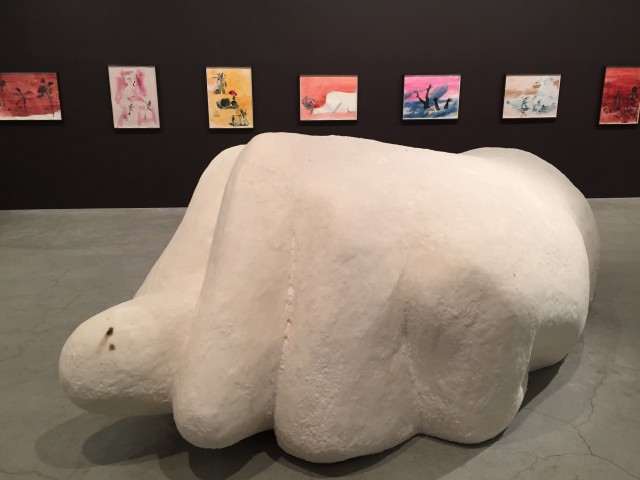Sikkema Jenkins & Co.
520 West 22nd St. between Tenthy & Eleventh Aves.
Tuesday – Saturday through January 17, free, 10:00 am – 6:00 pm
212-929-2262
www.sikkemajenkinsco.com
Brooklyn-based multimedia artist Kara Walker didn’t have much to say about her staggering installation “A Subtlety or the Marvelous Sugar Baby: an Homage to the unpaid and overworked Artisans who have refined our Sweet tastes from the cane fields to the Kitchens of the New World on the Occasion of the demolition of the Domino Sugar Refining Plant” before and during its May 10 to July 6 run in Williamsburg. Instead, she let the work, a monumental white sphinx/mammy hovering over a collection of molasses-dripping “Sugar Babies,” speak for itself to more than 130,000 visitors who came to experience it (and posted nearly 20,000 photographs to Instagram and Twitter). Walker has now followed that up with “Afterword,” a telling three-part exhibit at Sikkema Jenkins that gives new perspective on the work, which was commissioned by Creative Time. The first room contains a series of preparatory sketches, including a 2013 ink-and-watercolor version of the central figure throwing up and a cut-paper black silhouette of the sphinx on archival board, reversing the black-white, racially charged color scheme. The second room is dominated by the sphinx’s left fist, along with several “Sugar Babies”; watercolors in bold pinks, yellows, blues, and reds made during the run of the installation that reveal aspects of the history of the sugar trade and the building of the sphinx, visualizing the construction activities in terms of slavery; and the large-scale gouache-on-paper “Terrible Vacation,” a swirling horizontal update of J. M. W. Turner’s The Slave Ship (which plays an important role in the new film Mr. Turner).

Kara Walker has the last word in examination of her popular Domino Sugar Refinery installation (photo by twi-ny/mdr)
In the third room, a brown maquette of the sphinx sits in a glass case, surrounded by more sketches, including a twenty-panel narrative on the history of sugar production, leading to a screening room that shows a pair of films: For An Audience, six cameras captured the last hour of the installation, as visitors took pictures in front of the work, stared in disbelief, cried, laughed, and, in the final few minutes, were allowed to touch it, each person relating to it in a unique way. “During its eight week run,” Walker writes about the twenty-eight-minute film, “conversation around A Subtlety wound its way across different social media platforms to become an object of contention as well as reverence, and a talking point about historic injustice, artistic hubris, the public gaze, responsible viewership, black audiences vs. white ones, black female representation, aggressive male behavior, self recognition, and ‘selfies.’ . . . It was certainly a curiosity.” Of course, she knows it was much more than a curiosity, continuing, “One could observe many meanings taking shape in individual viewers, and unlike most contemporary art events — especially one featuring large nude female figures with negro physiognomies and colossal genitalia — full families with small children, elderly churchgoers, artists, grandstanders, and a general public of all shapes came out each weekend in large numbers to bear witness.” If you were not able to bear witness yourself when the piece was on display in Brooklyn — the lines did tend to get rather long at prime times — you can at least get a feel for what all the deserved hoopla was about through this exhibit, which looks at the before, during, and after, culminating in the other film being screened, the six-and-a-half-minute Rhapsody, which shows the installation being torn down to the “exuberant” sounds of Emmanuel Chabrier’s 1883 orchestral composition, “España.”
